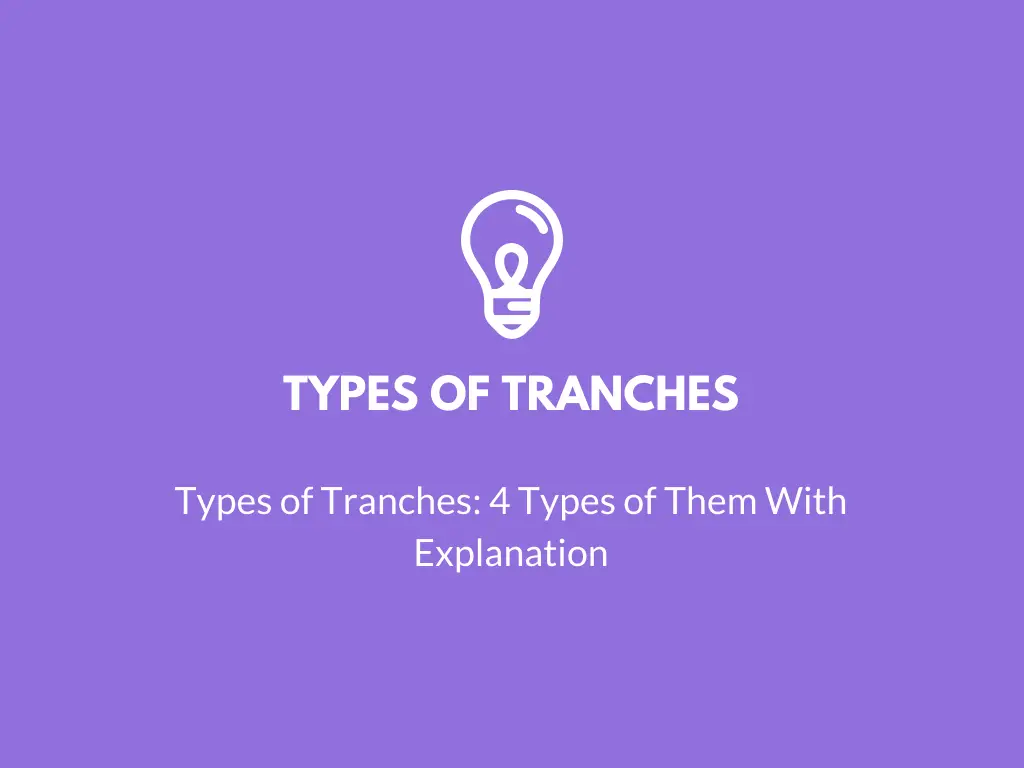Introduction
In the financial world. Tranches are mostly referred to as security stocks, or bonds (or any other applicable financial instrument) that is divided into relatively smaller denominations to be sold to consumers.
It allows investors and individuals to invest in smaller portions so that their risks and returns can be managed accordingly.
Therefore, it is imperative from the perspective of investors to be able to get the liberty to invest in denominations they like so that they are not mitigated by larger portion sizes.
Using tranches, investors can easily choose the investment style they desire, and invest accordingly.
There are numerous different types of tranches, and they vary from different parameters. In this regard, there are three different types of parameters that are in this context, which further have more subcategories within their umbrella.

Types of Tranches
As mentioned earlier, it can be seen that tranches are normally a collection of securities that are separated, and grouped based on the underlying characteristics. They are subsequently sold to the investors depending on their preferences.
The differentiating factor between tranches is the maturity date, credit ratings, as well as interest rates. They are mostly common with Mortgage Backed Securities, which are backed by assets in nature.
They are various different instruments that are clubbed together in order to provide for a relatively flexible investment portfolio to the investors.
In order to understand the different types of tranches, it can be seen that they can broadly be categorized into three categories.
1) Tranches Based on the Nature of Security
There are two main types are tranches that are set in accordance with the nature of underlying security. These can be defined as Mortgage-Backed Security and Asset-Backed Security.
Commercial Papers are used to settle Corporate Debts. However, it must be taken into account that interest rates often vary with these types of tranches. Mostly, they are lower for initial years, and are higher in later years.
2) Tranches Based on Maturity Period
Tranches that are based on maturity period are classified on based on maturity periods. They include securities that have maturity timelines varying from 12 months, to five years.
If the financial arrangement is for a shorter time frame, it is important to opt for short period maturity securities. Alternatively, if the financial arrangement is for a longer time period, tranches based on longer time durations are preferred.
3) Tranches Based on Credit Ratings
Tranches are also based on the overall risk profiles. Some tranches are highly risky, whereas others have low to moderate risk. Low-Risk tranches have a senior rating, of AAA, AA, or A. On the contrary, tranches rated BB or B are more risky.
Depending on these three parameters, tranches are designed so that they can sit the investor related profile, and a properly well sought investment strategy can be determined.
In this regard, it is also important to note that all the tranches created mostly have different characteristics which eventually shape the eventual decision taken by the individuals based on their existing profiles.
4) Mortgage Backed Securities
When it comes to Tranches, it can be seen that tranches in the Mortgage Market are the ones that are most commonly used, and widely spread.
As a matter of fact, it can be seen that Mortgage-Backed Securities, including collateralized mortgage obligations (CMOs) are found in the form of a tranche.
These are the securities that are mostly divided based on their maturities and credit ratings in order to attract different buyers in this regard.
Speaking of mortgage-backed securities, it can be seen that they constitute baskets of mortgages that are clubbed together for the investors to purchase. It is quite similar in nature to a bond, primarily because of the reason that it renders interest.
However, it must be noted that Mortgage-backed securities often pay rates that are based on the interest rates of the existing collection of loans. It also accounts for costs that are associated with the processing fee and other relevant expenses.
Conclusion
Therefore, there is no doubt to the fact that tranches can be considered as a very vital financial product that enables investors to add a much needed layer of customization in their investment portfolio.
Given the various different types of tranches that exist, it can be seen that it has eventually resulted in the financial market evolving considerably.
Tranches can be used to facilitate a much needed flexible model for investors, which can help them customize their investment strategies.
